Sitian Zeng
Review of Sitian Zeng’s Work
by Anna Gvozdeva
Sitian Zeng‘s painting orchestrates a constellation of glitches, gestures, and fragments that resist linearity and invite the viewer into a space where painting behaves like a screen, as both surface and portal. Zeng’s rhizomatic painting approach is not merely a reference to the terms of Deleuze and Guattari, but rather brings it to life in the painting: Multiple canvases in the work Entanglement expand horizontally, drifting across the wall like overlapping windows on a computer screen and forming fragmented interfaces with no clear beginning or end.
Zeng’s paintings are not content with the ‘representation’ at the semiotic level, but rather treat painting as an embodied practice. This becomes particularly touching in the repeatedly depicted ‘outstretched arms’ and ‘distorted digital characters’. Within collapsing digital interfaces, figures stretch, twist, and hover, caught mid-movement. The dotted colours and repetitive brushstrokes echo digital pixels and slow down the viewer’s gaze, drawing them into a meditative space. The twisted figures that appear in the work are not for the purpose of ‘completing a painting’, but rather seem like the painting itself is struggling and seeking a way out. Even if these marks deliberately simulate digital textures, it is actually a resistance to the smooth surface of the digital world. Painting is a way to regain control of perception and reflect on everyday rhythms in the post-digital age.
What moves the viewers most in Zeng’s work is not only the techniques applied, but rather a constant question: ‘Who am I in the post-digital age?’ Zeng is not painting to criticise technology, but to immerse oneself in that fragmented interface, in the interaction with the digital code which we normally do not see, inviting us to project our imagination into the figures. Through all the detailed marks, painting becomes less a mirror of the digital world and more a tactile negotiation with it—an embodied form of meditation through which one reflects on the relationship between ‘me and the world’.
Year of birth: 1995
Where do you live: Glasgow
Your education: PhD Candidate at the Glasgow School of Art
Describe your art in three words: Intuitive, Reflective, Interdisciplinary
Your discipline: Visual Art
Website | Instagram
Your work navigates between painting, digital media, and philosophical inquiry. How did the concept of the “rhizome” become central to your artistic process?
As an artist and practice-led researcher, I develop a method of rhizomatic painting to enable a flexible and open-ended painting practice. A rhizome is a plant structure that grows horizontally and spreads out without a central root. Philosophers Gilles Deleuze and Felix Guattari introduced the rhizome as a metaphorical and philosophical concept in 1980, proposing a non-hierarchical wayof thinking that challenges the binary logic represented by the tree structure. The rhizome, as its image implies, forms a network in which all elements are constantly connected and interwoven, without a singular beginning or end.
This concept aligns with my understanding of painting and the theme of my practice, subjectivity in the post-digital condition. We are living in an age where digital screens are ubiquitous, blurring the boundaries between the virtual and physical. When we sit in front of different devices, our attention readily slides into a virtual world. Thus, I consider my canvas a metaphorical screen and my painting practice an intuitive mapping process, just like how a digital screen invites users to enter a virtual realm that connects numerous spaces, information and the invisible code. My painting expands like a rhizome horizontally. In the painting Entanglement, multiple canvases are considered as one painting. It weaves together various digital visual elements such as 3D-modelled figures and digital code, layering digital and virtual realms with physical paintings. In this case, the rhizomatic thinking emphasises connection and heterogeneity, enabling my engagement with many layers of my practice: painting’s materiality, subjectivity and our embodied digital experiences.
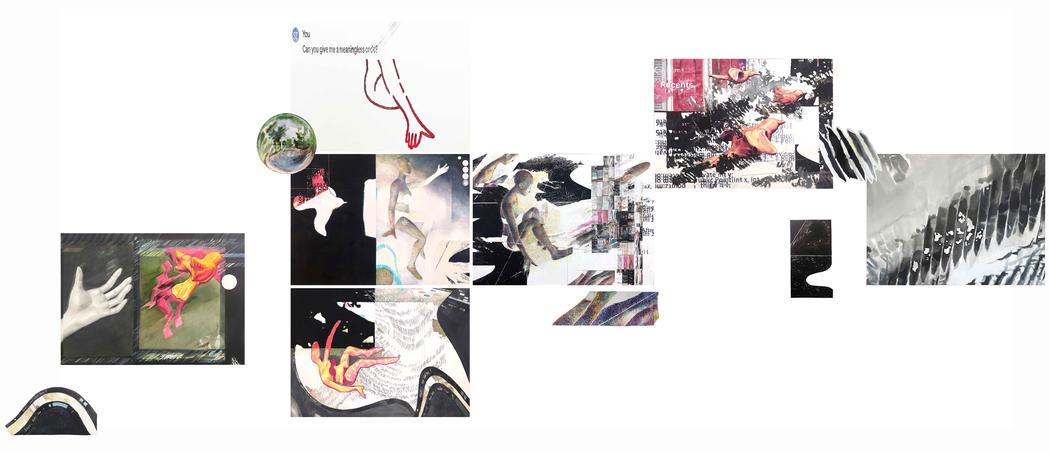 Sitian Zeng | Entanglement
Sitian Zeng | Entanglement
In the Entanglement series, you translate 3D-modelled figures into paintings. How does this transformation reflect your views on identity in the post-digital age?
I am especially interested in how subjectivity and identity are shaped by the overwhelming digital information and images in the post-digital age, and I explore this topic in my painting. My initial reason for depicting the 3D-modelled figures was an attempt to imagine and project my subjectivity into different figures. Sometimes it is a human figure, sometimes it is a bird—both serving as metaphors for digital characters. Much like in video games, where we begin by selecting a basic avatar, our subjectivity is carried by that character and gradually grows through interactions with various virtual challenges.
In my painting Entanglement, I began with the figure shown in Detail 1. I then imagined how, within this metaphorical screen, my subjectivity is entangled in the digital surroundings and the overwhelming and blurring screenshots, and I gradually expanded my painting. This process enables me to reflect upon my digital experiences and my identity. Another example is in Detail 2, where the bird seems to be attempting to fly out of the canvas, and the canvas represents the screen. However, if you look closer, you may notice that the depicted grid lines, which are often shown in the 3D software interface, are still attached to this bird. It is flying, yet can never escape, because it is born into this digital realm. This detail resonates with how I feel my subjectivity is permeated by the digital world.
The repetition of the outstretched arm is striking. Can you elaborate on its symbolism in your visual language?
The gestures of figures always play an important role in my paintings, and I always realise their meanings after choosing them intuitively. After I finished the painting Entanglement, I noticed I repeatedly depicted figures with outstretched arms, which can be seen in the images of Detail 3 and Detail 4. Reflecting on my digital experience, I see that the gesture embodies my attempts to reach something ungraspable in a fleeting image culture. Since I often project my subjectivity into the different characters in my paintings, I choose to depict the gestures of figures based on how I imagine my body might move in a digital and virtual space. Am I contemplating? Or am I interacting with something intangible? All the outstretched arms may imply a sense that we are always searching for something in a digital network.
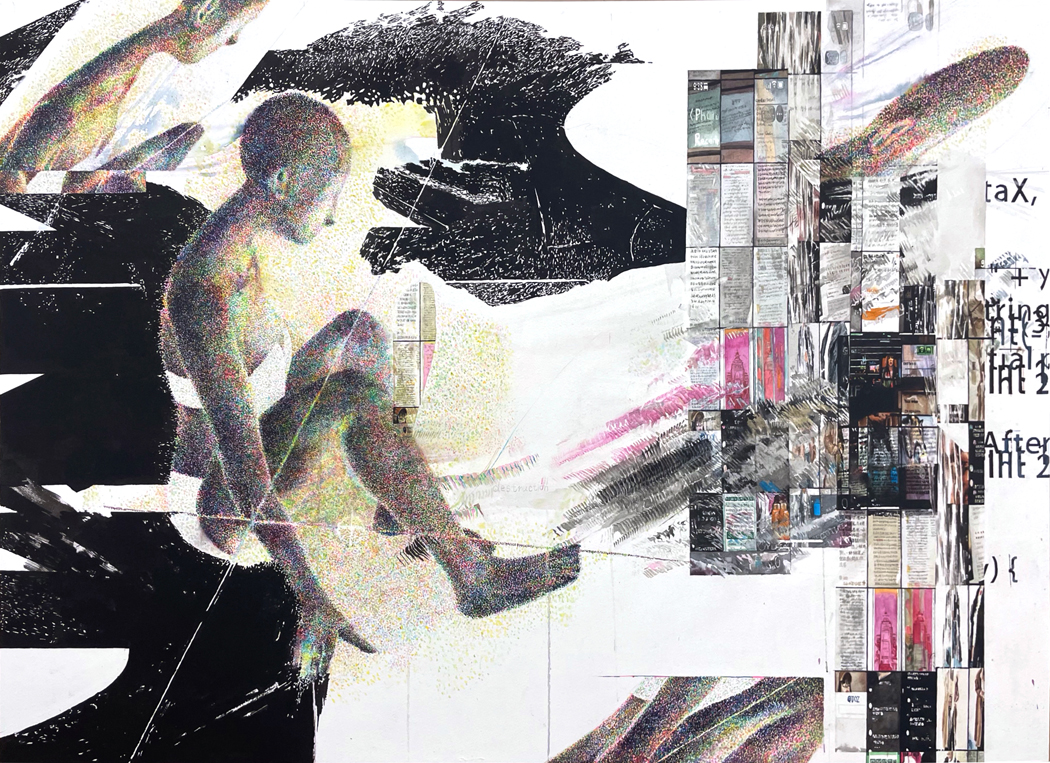 Sitian Zeng | Detail 1
Sitian Zeng | Detail 1
Your canvases often resemble glitchy or fragmented interfaces. What role does digital error or distortion play in your critique of media saturation?
The appearance of digital glitches and distortion serves many purposes in my painting, including reflecting on media saturation. I understand the digital world as a composition of multiple fragmented interfaces with the invisible code and algorithms running beneath. Thus, in Entanglement, I use the visual effects like glitches and marks resembling digital brushes to create a metaphorical interface, inviting viewers to a digital realm.
Glitch is not only repetitive patterns representing digital errors, but also brings philosophical enquiries. As discussed in the book Glitch Art in Theory and Practice by Michael Betancourt, glitch can act as an ‘inflexion point’, which can be considered as a minor technical bug in digital operations or trigger our deeper critical reflection on the stability of the system. For me, as an artist, this rupture and the depicted digital noise are my ways of resisting the illusion of a smooth digital interface and the constant flow of information, which we often ignore when we are bombarded by the overwhelming digital content.
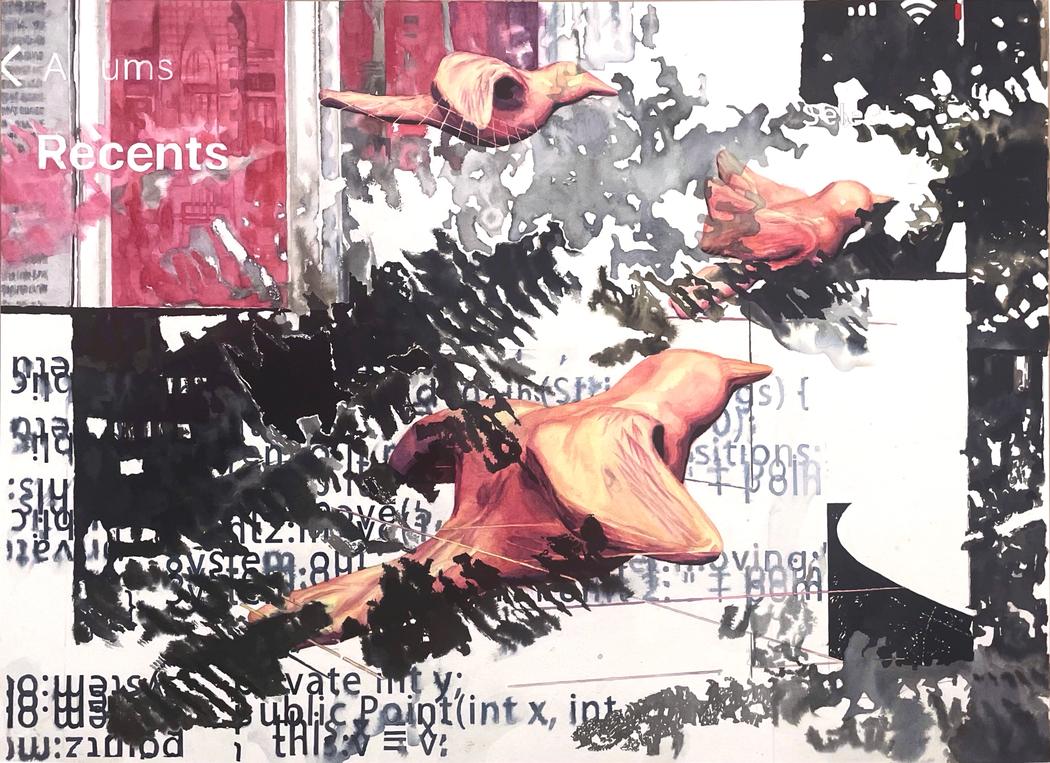 Sitian Zeng | Detail 2
Sitian Zeng | Detail 2
You describe the canvas as a metaphorical screen. How do you differentiate between representing versus embodying the digital within painting?
This question really points to one of the important aspects of my painting and research. Since I started my practice based on the theme of subjectivity in the post-digital age two years ago, I have always been thinking about the concept of ‘beyond representation’. As a figurative painter, I am fascinated by the beauty and meaning that figures can carry and imply. At the same time, I recognise that there is something beyond semiotics and something deeper than graphics and images. Especially, painting is a composition of not only the result of lines, colours, and figures, but also the artist’s body movement and feelings. It makes the depicted figures not only refer to their meaning framed by the culture and knowledge but also be the incarnation of the artist’s intuition and sensation.
I emphasise these layers of intuition and sensation in my painting practice, which points to the dimension of individual embodiment. I always believe there is something that is inherent in our body but has not yet entered the realm of linguistics. Just like when we were babies, we cried or grasped the air to express our need. When we grow, even though we get to know how to convey our needs through language, there are still something carried by our body that are difficult to express. In the post-digital condition, our body keeps absorbing the impact of all virtual information and high technologies. It may be difficult for us to fully articulate our feelings in language. I attempt to use painting as a sensual meditation to reflect on them. In my painting, especially in Detail 4, the distorted figures and the twisted interface visualise my sense of falling in a digital world overwhelmed by algorithms. Pointillism is the resistance of the digital mechanism, which builds a contemplative space for me. I allow the representation and the embodied expression, pulling my practice into different directions and possibilities. The figurative images trigger my sensation and then, in return, allow me to add new juxtapositions in the rest of the painting; this process kept happening.
Back to the question, I won’t say that I differentiate the representation and embodiment, it is a process I see my embodied experience through representational images or vice versa. But I am still in the process of exploring these two aspects, and I try to explore deeper.
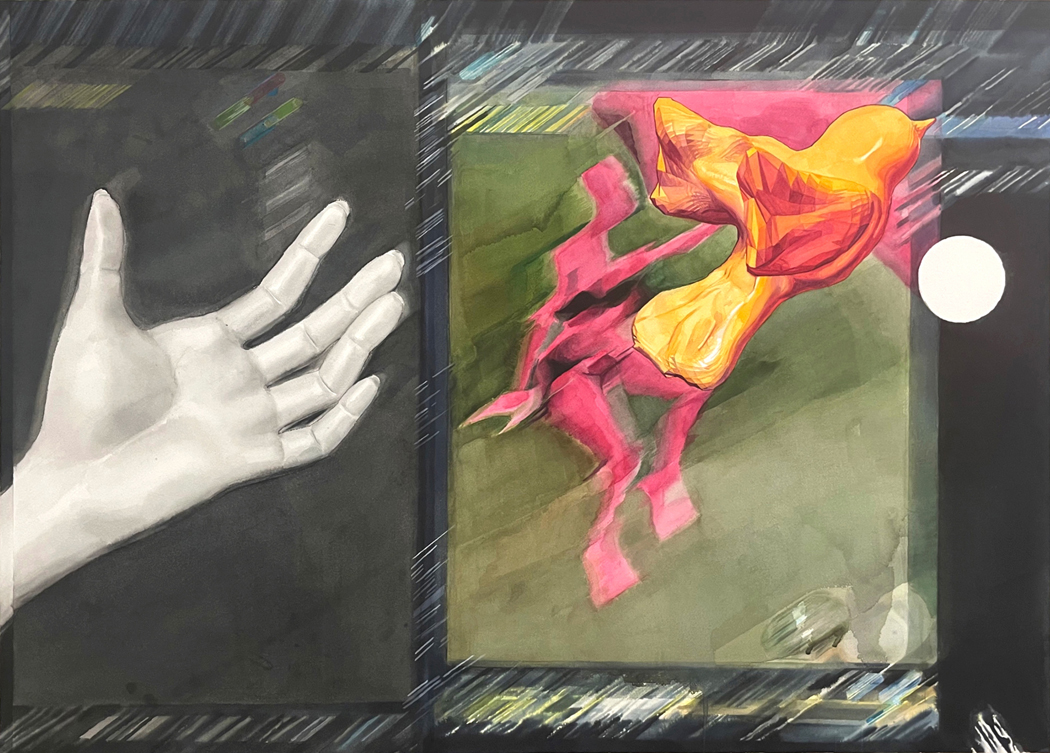 Sitian Zeng | Detail 3
Sitian Zeng | Detail 3
How do Foucault’s ideas about power structures inform your understanding of digital subjectivity?
I am always fascinated by the dynamic power structure in different systems and try to raise certain questions or reflect on them through my painting practice. Michel Foucault’s concept of power was an initial influence on my practice. He proposes that power is productive instead of repressive, and it shapes how we understand and form ourselves. This triggered me to reflect on how algorithmic systems and the surrounding screens regulate our behaviour and perception. It raises my interest in an individual’s position in the digital network, as we keep shifting between the controller and the one being controlled.
I later turned my focus to a more post-structuralist view of power, and I mainly read the book by Deleuze and Guattari, who think power is always flux and in a state of constant becoming. The shift of identity still deeply influences my painting practice and exploration of subjectivity. For example, as I project myself into the depicted figures, I am that figure, but I am also its creator. I imagine I am trapped and exist in such a metaphorical screen, but I am also outside of this screen. This reflection on the tension of being subject, observer and creator points to how subjectivity is constantly shaped within a fluid and dynamic power structure in the post-digital age.
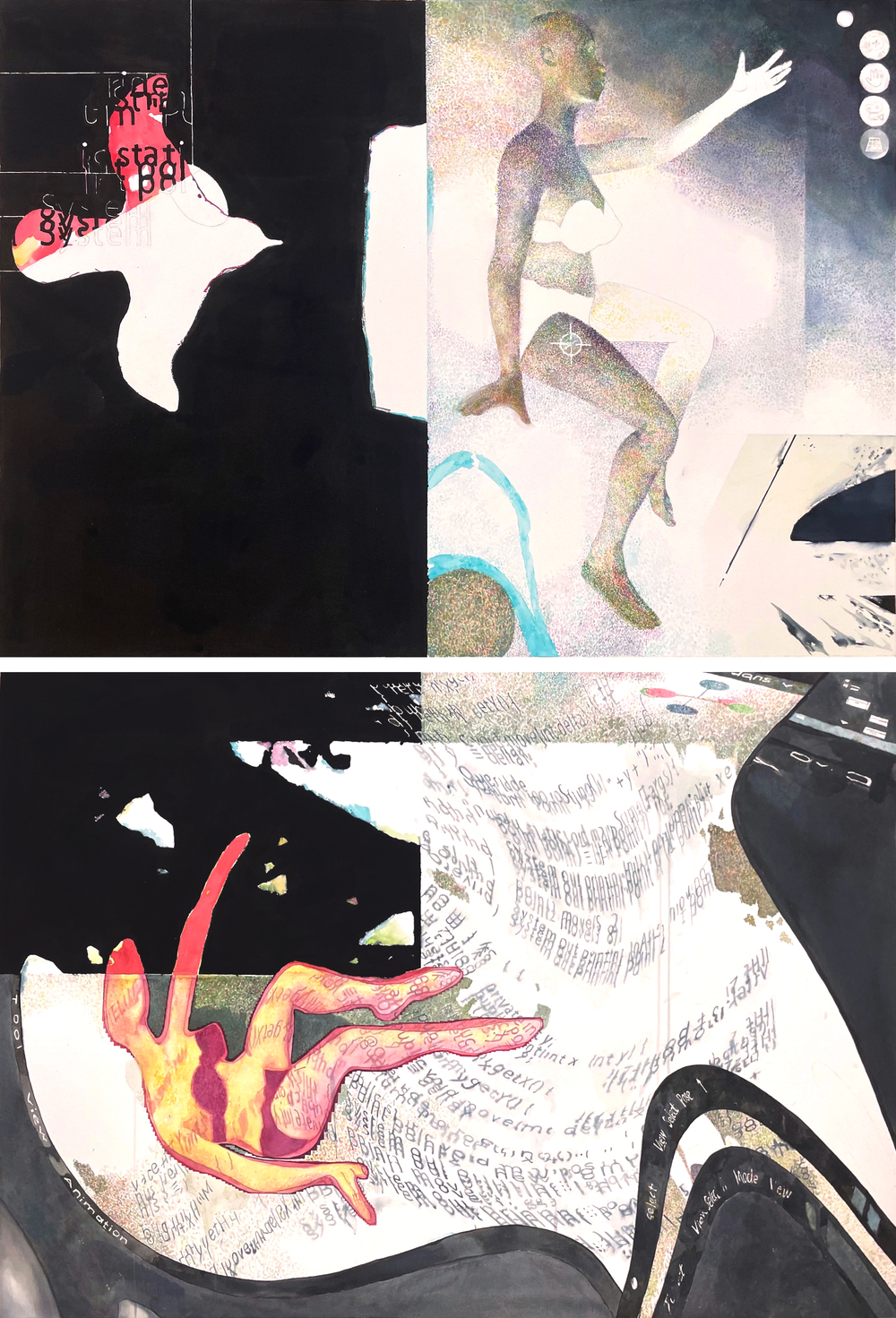 Sitian Zeng | Detail 4
Sitian Zeng | Detail 4
What does spontaneity look like in your rhizomatic approach to painting—especially in relation to coding, systems, and control?
A rhizomatic approach emphasises how different elements connect spontaneously and create unexpected impacts on viewers. In my painting practice, I don’t have any predetermined sketches for colours or composition. Instead, I start with a figure or an abstract mark that triggers me most at that moment. I paint intuitively, allowing the act of depiction and the emerging image to evoke my sensations or thoughts, which then give me new ideas to expand my paintings.
I have an original ‘database’ of various elements related to the digital, such as coding patterns, 3-D modelled figures, or screenshots. I may start with my database. However, when I have an idea to expand my painting, I respond to this idea immediately and form a spontaneous juxtaposition.

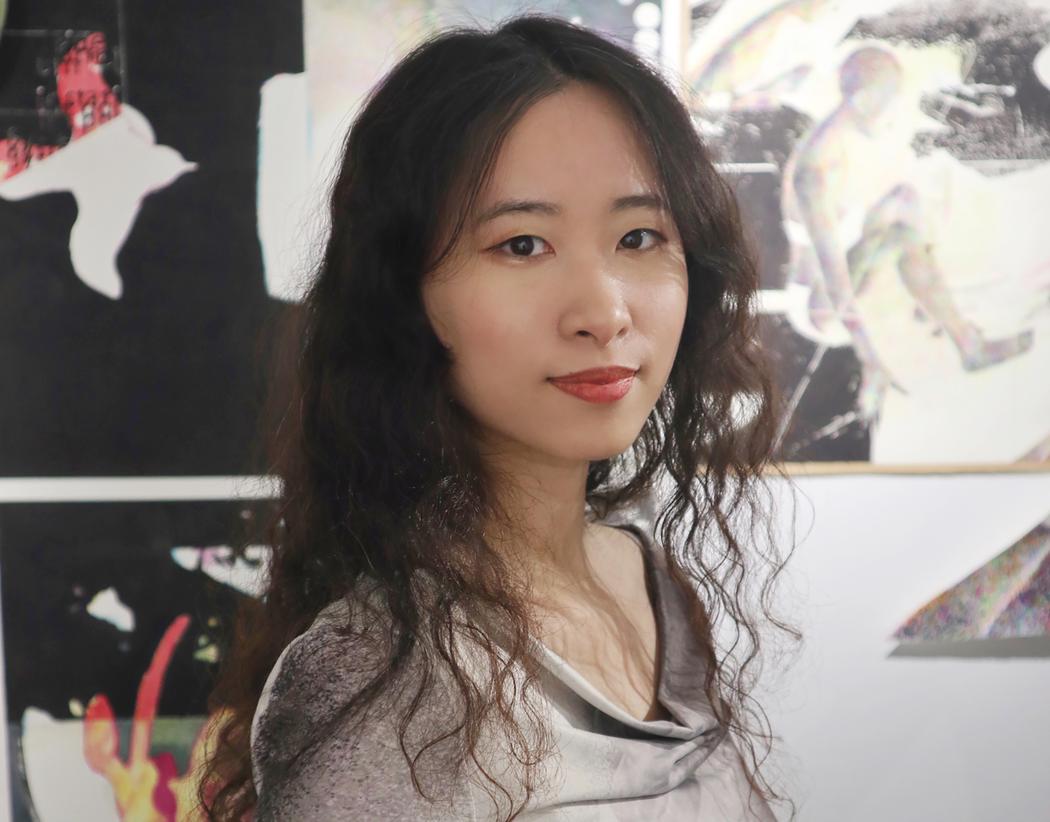
Leave a Reply
You must be logged in to post a comment.